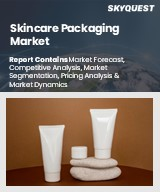
세계의 스킨케어 포장 시장 규모는 2023년에 165억 달러로 평가되었고, 2024년 171억 6,000만 달러에서 2032년에는 234억 8,000만 달러로 성장해 예측기간(2025-2032년)의 CAGR은 4.0%를 나타낼 전망입니다.
세계의 스킨케어 포장 시장은 노화 방지 효과, 천연 성분, 지속 가능성을 강조한 제품에 대한 수요 증가로 급성장하고 있습니다. 소비자 인식이 높아지고 프리미엄화 추세가 강화되면서 혁신적이고 고품질이며 친환경적인 포장 솔루션으로의 전환이 두드러지게 나타나고 있습니다. 이러한 성장은 소재 과학의 발전에 힘입어 더욱 가속화되고 있으며, 브랜딩에 필수적인 독특하고 지속 가능한 디자인이 강조되고 있습니다. 특히 아시아태평양 지역이 시장을 주도하고 있으며, 중국, 한국, 일본 등 국가들의 상당한 미용 제품 소비가 이를 견인하고 있습니다. 또한 에어리스 디스펜서와 스마트 포장의 부상은 제품의 유통기한, 무결성 및 사용성을 향상시킵니다. 럭셔리 스킨케어 브랜드들은 점점 더 세련미와 기능성을 결합한 포장에 투자하여 형태와 사용자 경험 모두를 개선하고 있습니다.
Global Skincare Packaging Market size was valued at USD 16.5 billion in 2023 and is poised to grow from USD 17.16 billion in 2024 to USD 23.48 billion by 2032, growing at a CAGR of 4.0% during the forecast period (2025-2032).
The global skincare packaging market is experiencing a surge driven by the growing demand for products featuring anti-aging benefits, natural ingredients, and sustainability. As consumer awareness increases and the trend towards premiumization strengthens, there is a notable shift towards innovative, high-quality, and eco-friendly packaging solutions. This growth is further propelled by advancements in materials science, emphasizing unique and sustainable designs essential for branding. Notably, the Asia-Pacific region leads the market, fueled by significant beauty product consumption in countries like China, South Korea, and Japan. Moreover, the rise of airless dispensers and smart packaging enhances product shelf life, integrity, and usability. Luxury skincare brands are increasingly investing in packaging that marries sophistication with functionality, improving both form and user experience.
Top-down and bottom-up approaches were used to estimate and validate the size of the Global Skincare Packaging market and to estimate the size of various other dependent submarkets. The research methodology used to estimate the market size includes the following details: The key players in the market were identified through secondary research, and their market shares in the respective regions were determined through primary and secondary research. This entire procedure includes the study of the annual and financial reports of the top market players and extensive interviews for key insights from industry leaders such as CEOs, VPs, directors, and marketing executives. All percentage shares split, and breakdowns were determined using secondary sources and verified through Primary sources. All possible parameters that affect the markets covered in this research study have been accounted for, viewed in extensive detail, verified through primary research, and analyzed to get the final quantitative and qualitative data.
Global Skincare Packaging Market Segments Analysis
Global Skincare Packaging Market is segmented by Type, Material, Product type and region. Based on Type, the market is segmented into Jars, Tubes, Bottles, Pumps & Dispensers, Sachets and Others. Based on Material, the market is segmented into Glass, Paper, Plastic, Metal and Others. Based on Product type, the market is segmented into Hand Care, Depilatories, Make-up Remover, Sun Care, Body Care and Facial Care. Based on region, the market is segmented into North America, Europe, Asia Pacific, Latin America and Middle East & Africa.
Driver of the Global Skincare Packaging Market
The Global Skincare Packaging market is significantly influenced by shifting consumer preferences toward sustainable and eco-friendly products, presenting a challenge for brands in their packaging design efforts. Eco-conscious consumers prioritize packaging made from biodegradable materials, post-consumer recycled plastics, glass, bamboo, or paper. Brands that fail to resonate with the values of these environmentally aware shoppers, especially those from the Gen Z and millennial cohorts, risk losing their loyalty and trust. Additionally, a multitude of global regulations, including plastic bans in various regions, has heightened the demand for sustainable packaging solutions, further driving the market toward eco-friendly alternatives.
Restraints in the Global Skincare Packaging Market
While the desire for biodegradable and high-quality recyclable materials in the skincare packaging market is increasing, the associated costs for implementing such features remain prohibitively high. Materials like PLA bioplastics, sugarcane-based polymers, and glass containers often come with price tags that significantly exceed those of conventional plastics. This financial burden disproportionately affects small and medium-sized enterprises, eroding their profit margins and hindering their ability to adopt sustainable packaging solutions. Consequently, these businesses may struggle to compete in a market that increasingly prioritizes eco-friendly options, limiting their overall participation in the shift towards sustainability in the industry.
Market Trends of the Global Skincare Packaging Market
The Global Skincare Packaging market is increasingly leaning towards individualized and smart packaging solutions that cater to the unique preferences of consumers. Incorporating innovative features such as temperature indicators, augmented reality overlays, and mobile app integrations not only enhances user engagement but also elevates the overall skincare experience. This trend towards personalization is propelled by advancements in AI skin analysis and user-driven content, prompting brands to invest in packaging that reflects individual routines and preferences. As consumers seek more tailored products, brands are responding by designing packaging that not only protects the product but also serves as an interactive tool in skincare routines.